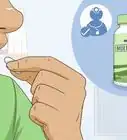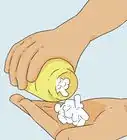This article was co-authored by Monica Morris. Monica Morris is an ACE (American Council on Exercise) Certified Personal Trainer based in the San Francisco Bay Area. With over 15 years of fitness training experience, Monica started her own physical training practice and gained her ACE Certification in 2017. Her workouts emphasize proper warm-ups, cool-downs, and stretching techniques.
There are 9 references cited in this article, which can be found at the bottom of the page.
wikiHow marks an article as reader-approved once it receives enough positive feedback. This article received 15 testimonials and 91% of readers who voted found it helpful, earning it our reader-approved status.
This article has been viewed 3,901,431 times.
You've seen them at the gym and on countless vanity Tumblr pages - impossibly buff lower abs that make a raised "V" shape above the pelvis. Do these tremendously tight midsections leave you feeling envious? Is your own flabby, doughy stomach no longer "cutting" it? Have no fear - with an aggressive abdominal workout and smart fat-cutting decisions, you too can build up an eye-catching V cut. Be warned - some people may be more genetically predisposed to this feature than others. See Step 1 below to get started.
Steps
Strengthening Lower Abs
-
1Hit your lower ab region with a variety of exercises. The rectus abdominis (your "six pack" muscle) stretches from the bottom of your chest down to your pelvis.[1] Though many work out the upper and middle portions of this muscle with sit-ups and crunches, for a strong, defined V cut, it's best to include workouts that hit the lower abs as well. A varied lower ab routine, in addition to building strength and definition in the region, can build overall core strength and reduce the risk of back pain. Below are some examples of lower ab exercises that can help you work on that V cut.[2]
-
2Do leg lifts. This exercise builds lower ab strength by forcing your abdominal muscles to raise your hips and legs off of the ground in a vertical column. To do this exercise:
- Begin by lying flat on your back. You can use a mat for comfort. Put your palms face-down at your sides.
- Lift your legs off of the ground so that they are pointing straight up towards the ceiling. Your body should form an "L".
- Concentrating on using your lower ab muscles, gently lift your hips off the floor, keeping your legs straight. Hold for a second, then lower your hips back to the floor. Use smooth, controlled movements - don't bounce or jerk.
- Repeat. Do this exercise until you feel the telltale "burn", or for 4 sets of 15 reps.
- To increase the intensity of this exercise, keep your arms off of the floor. You can hold them up above the ground or raise them above your head.
Advertisement -
3Do hanging leg raises. This powerful exercise requires you to suspend yourself from a chin-up bar. In addition to building your lower abs, this exercise will, as a side benefit, increase your grip strength. To do this exercise:
- Hang beneath a chin-up bar or another sturdy horizontal bar. Use a medium-wide grip. Your body should point straight towards the ground, with your hips very slightly rolled back.
- Raise your legs, knees bent, until your thighs make a 90-degree (L-shaped) angle with your torso. Hold this shape for a second, then gently lower your legs back to their starting position.
- Avoid twisting, jerking, or swinging your feet for this exercise. Improper form can cause pain or even injury.
- Repeat the exercise until you feel the burn, or for about 3-4 sets of 10-20 reps.
- Variations on this exercise exist. To make the exercise easier, you can use a specially-designed vertical bench which includes pads to rest your arms on. For an added challenge, you can want to keep your legs straight as you raise them or even add a weight between your feet. However, use caution when making this exercise more difficult - too much weight too fast carries the risk of a hernia.[3]
-
4Do reverse crunches. These fairly simple lower ab exercises are a great addition to any ab workout. To do this exercise;
- Begin by lying on your back with your legs raised in a "tabletop" position - your legs raised with knees bent. In other words, your thighs should form a 90 degree angle with the ground and your shins should form a 90 degree angle with your thighs.
- Spread your arms wide with your palms touching the ground. This provides a wide base to help you balance.
- Keeping your upper back still, use your lower abs to lift your hips off the floor. Your knees should come towards your chest.
- Hold this position for a second, then lower your hips back towards the ground gently.
- Repeat until you feel the burn, or for several sets of 12-20 reps.
- This exercise can be made more difficult by holding a small dumbbell between your feet. However, as always, use caution when performing ab exercises with extra weight to avoid injury.
-
5Do an ab V hold. The ab V hold requires you to balance in a position that requires lower abdominal strength to maintain and to hold this position. The longer you do the ab V hold, the greater the burn you'll feel. To do this exercise:
- Begin by laying flat on your back.
- With both hands at your side, gently and carefully raise both your legs and your torso about 45 degrees off the floor. Your body should form a "V" with your hips touching the floor. Keep your legs straight and maintain strong, balanced posture.
- Brace your ab muscles and uses your arms for balance. Some people find it easier to balance if they extend their arms parallel to the floor, pointing in the direction of their legs. However, if you do this, don't use your arms to support your legs at all.
- Hold this position. Hold this position until you feel the burn, usually about 30 seconds to 2 minutes. Repeat as needed.
- You can also do this exercise while seated in a chair. Scoot forward to the edge of the chair, then put your legs together. Lean back and grab onto the chair while you lift your legs up. Keeping your legs straight, bring your feet up toward the ceiling so they're 6–12 inches (15–30 cm) above the floor.[4]
-
6Maintain a balanced core routine. Though your V cut mostly depends on your level of body fat, your genetics, and your lower ab strength, it's a very wise idea to practice a comprehensive core routine. Not only will this give your midsection a "rounded out" appearance, rather than a lopsided or uneven one, it'll improve your overall strength, comfort, and health. Core strength is frequently correlated with relief from back pain[5] and other common maladies. So, before you pursue your V cut with dogged determination, be sure to plan on working out the rest of your core as well. Below are a few exercises you might consider:
- Side crunches. These easy exercises modify the basic crunch so that it hits both your obliques and your central ab muscles.
- Bridges. These exercises are great for strengthening the lower back without straining it. A great choice for people with lower back pain.
- Lunges. Don't forget that your hips and legs are part of your core! Lunges are body weight exercises, that, in addition to strengthening your thighs, glutes, hips, and back, can improve your sense of balance.
- Yoga poses. Yoga is a highly effective, yet relaxing way to improve your core strength. It also has numerous side-benefits, including increased flexibility and balance.
Cutting Body Fat
-
1Have a lean, healthy diet. Even the strongest, most well-developed ab muscles are invisible if they're buried under fat - most heavyweight power lifters, for instance, have tremendously strong cores, but can appear fat because of their relatively high level of body fat. If you have abdominal fat around your midsection, cutting your level of body fat is an absolute necessity if you're interested in getting a V cut, and one of the best ways to do so is with a weight-loss diet. Eat fewer calories than you burn each day, while making sure to get all of the nutrients your body needs to thrive, and you will lose weight at a healthy, controlled pace.
- There are countless weight-loss diets offered both online and in print. Some are healthy and sensible, others are amateurish and unrealistic, and still others are unhealthy. Most good weight-loss diets will recommend a diet based on some combination of the following advice:[6]
- Eat few sugary, fatty foods. Eliminate desserts from your diet, except for rare indulgences.
- Eat lean, filling protein. Chicken breasts are a great choice, as are certain types of fish and leaner cuts of red meat. Low-fat dairy, nuts, and seeds are also good choices.
- Eat fresh fruits and vegetables. These nutrient-dense, low-calorie foods are essential for maintaining your body's health.
- Eat sensible amounts of carbohydrates. Whenever possible, opt for healthier, more-filling whole-wheat varieties of bread and nutritious starch products.
- Your weight-loss diet shouldn't be based on starvation or purging. Everyone needs to eat to a certain degree each day. Depriving your body of the food it needs will leave you tired and irritable and dull your senses. You'll be less able to perform the muscle-building exercises you'll need to build your V cut muscles and you may even experience muscle loss. In truly severe cases, you can even seriously endanger your health.
- There are countless weight-loss diets offered both online and in print. Some are healthy and sensible, others are amateurish and unrealistic, and still others are unhealthy. Most good weight-loss diets will recommend a diet based on some combination of the following advice:[6]
-
2Do cardio exercise. Cardio is a great way to burn calories (and, paired with a healthy diet, fat). Cardio also has a variety of other health benefits - making cardio exercise part of your routine can lower your heart rate, improve blood flow, increase your daily energy level, and simply make you feel better.[7] A wide variety of cardio exercises require little in the way of special equipment or financial investment - for instance, jogging, running, walking, swimming, hiking, and cycling are enjoyed by millions of people all over the world every day. Your body is a furnace - light the fire and you'll see results.
- Running is one of the simplest, yet most intense and effective forms of cardio exercise. Balance running at high rates with jogging and walking to boost your metabolism. Rest at least a day between hard runs, but try to do some minor exercise on days off - for example, walk for half an hour.
-
3Drink lots of water. Drinking water has been thought for years to aid in, or even facilitate, weight loss.[8] More importantly, however, is its vital importance to nearly all bodily functions. Since you have (hopefully) started cardio exercise, you'll be losing much more water than usual through sweat, which you'll need to replace to keep yourself feeling alert, focused, and healthy. Many diets recommend at least 8 eight-ounce glasses of water per day.[9]
-
4Consider resistance training. Certain studies have shown that cardio exercise, rather than resistance (strength-training) exercise, is the best choice for losing weight.[10] However, some exercise aficionados swear by a combination of resistance training and cardio exercise, citing the fact that, while cardio alone can burn fat, building muscle through resistance training can raise your overall metabolism and thus increase the baseline caloric amount that you burn per day. If you're currently on a weight-loss diet, you're unlikely to build much muscle through resistance training. However, you will improve your form and, according to some sources, will greatly reduce the amount of muscle that you lose as you lose weight, instead losing fat almost exclusively.
- If you do opt for resistance exercise, perform a healthy, balanced regimen of weightlifting and body weight-type exercises. Proceed slowly - never jump straight to high-weight exercises, or you risk serious injury.
-
5Raise your overall activity level. One of the single most effective ways to lose fat doesn't involve drastic dieting or time-consuming exercise, which can be especially difficult to work into your schedule if you find yourself constantly busy. Simply look for opportunities to increase your physical activity level every day. Almost anything you can do to stay active throughout the day will have a boosting effect on your metabolism, which, all other things being equal, can cause you to lose weight. Try to look for ways to increase your activity during these everyday tasks:
- Daily commute/transportation. Rather than driving to work, consider walking, running, or biking. Investigate public transportation options, which will require you to walk to and from the stop.
- Work. If your job requires you to sit at a desk all day, look for opportunities to get out of the chair. Consider investing in a standing or walking desk, or, if you can, just place your computer on top of a box or two to create a "poor man's" standing desk. Switching up your desk routine is also a great idea for preventing back pain.[11]
- Home relaxation. Rather than relaxing on the couch in front of the TV at home, keep moving on an elliptical trainer or do some simple exercises (like jumping jacks or lunges) on the floor.
-
6Be consistent and patient. This kind of definition does not develop overnight.
Expert Q&A
Did you know you can get expert answers for this article?
Unlock expert answers by supporting wikiHow
-
QuestionWhat exercises help develop this?
 Michele DolanMichele Dolan is a BCRPA certified Personal Trainer in British Columbia. She has been a personal trainer and fitness instructor since 2002.
Michele DolanMichele Dolan is a BCRPA certified Personal Trainer in British Columbia. She has been a personal trainer and fitness instructor since 2002.
Certified Fitness Trainer Perform the exercises described in this article, and you will have the V. However, you may or may not be able to see it, depending on whether or not you have any body fat around your waist. To actually see the six-pack abs, you must have a very low BMI - probably below 20. That means, losing fat, eating leaner, and exercising more. The advice in this article is all you need.
Perform the exercises described in this article, and you will have the V. However, you may or may not be able to see it, depending on whether or not you have any body fat around your waist. To actually see the six-pack abs, you must have a very low BMI - probably below 20. That means, losing fat, eating leaner, and exercising more. The advice in this article is all you need. -
QuestionHow do I get six pack abs?
 Michele DolanMichele Dolan is a BCRPA certified Personal Trainer in British Columbia. She has been a personal trainer and fitness instructor since 2002.
Michele DolanMichele Dolan is a BCRPA certified Personal Trainer in British Columbia. She has been a personal trainer and fitness instructor since 2002.
Certified Fitness Trainer
-
QuestionCan a 14 year old do this?
 Community AnswerYes, a 14-year old can do this.
Community AnswerYes, a 14-year old can do this.
Warnings
- Do not starve yourself. Making eating healthy a part of your life, not a temporary phase. Therefore, consume enough calories to function, but not more than necessary. Eat more early in the day to increase energy, but not a lot at night.⧼thumbs_response⧽
- Do not do advanced weight routines alone, some routines may cause injury and "spotters" should be present.⧼thumbs_response⧽
References
- ↑ http://www.meddean.luc.edu/lumen/MedEd/grossanatomy/dissector/muscles/reca.htm
- ↑ http://www.webmd.com/back-pain/features/relieve-back-pain-with-core-strength-training
- ↑ http://www.bodybuilding.com/exercises/detail/view/name/hanging-leg-raise
- ↑ Monica Morris. Certified Personal Trainer. Expert Interview. 18 November 2019.
- ↑ http://www.webmd.com/back-pain/features/relieve-back-pain-with-core-strength-training
- ↑ http://www.mayoclinic.org/weight-loss/art-20048466
- ↑ http://www.mayoclinic.org/aerobic-exercise/ART-20045541
- ↑ http://www.webmd.com/diet/news/20040105/drinking-water-may-speed-weight-loss
- ↑ http://www.webmd.com/diet/news/20040105/drinking-water-may-speed-weight-loss
About This Article
To get V-cut abs, hit your lower core with 10-20 reps of leg lifts, hanging leg raises and reverse crunches every day. Mix in overall core exercises like side crunches and planks, as well as strength moves like bridges and lunges to balance out your overall look. To cut body fat, fill your diet with lean, satisfying protein like chicken breasts and low-fat dairy, plus plenty of fresh fruits and vegetables and at least 8 fluid ounces of water a day. Burn calories by running, swimming, or riding a bike to boost your metabolism and get faster results. For tips from our Personal Trainer reviewer, including how resistance training might help with definition, read on!
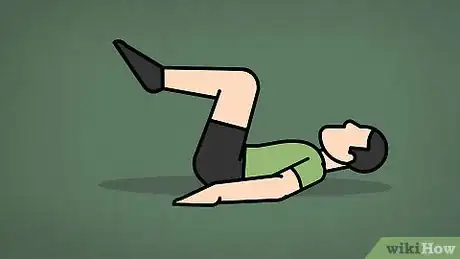

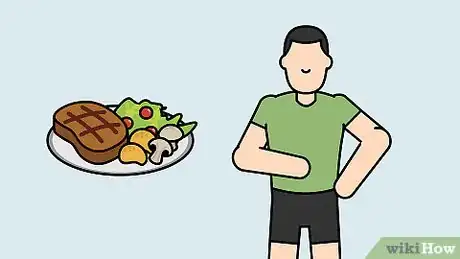

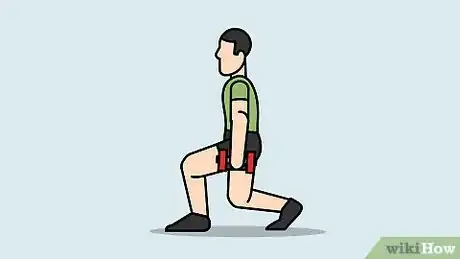
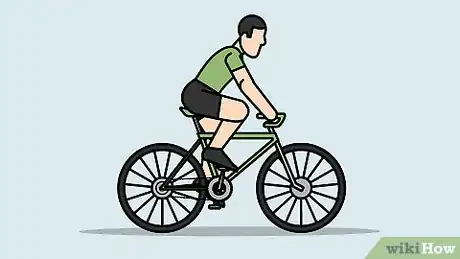
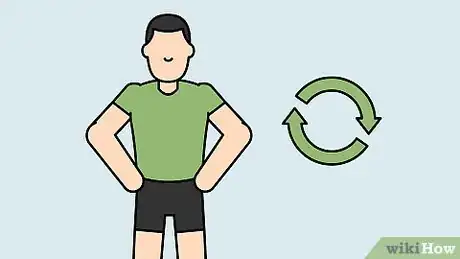

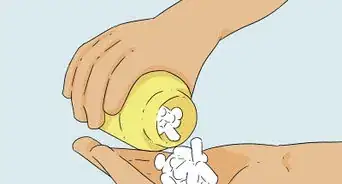
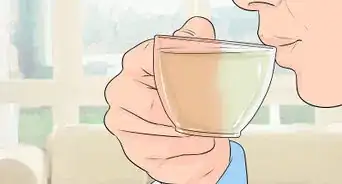
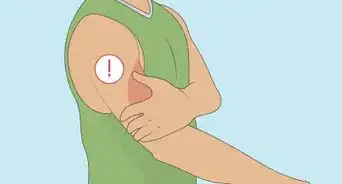
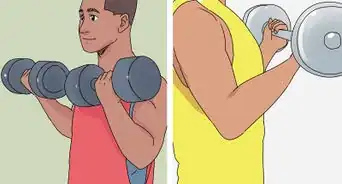
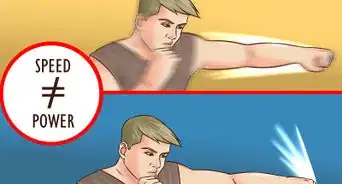

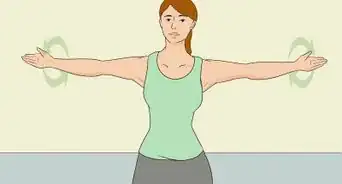
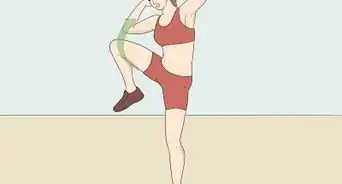
-Step-10-Version-5.webp)








